Growing amaryllis in water is easy, and it’s a cute way to display them for the holidays or give them as a gift. They can’t stay in water forever but will survive long enough to bloom.
It’s as simple as filling a vase with decorative pebbles or rocks, positioning your amaryllis bulb on top, and adding water. Then keep the roots submerged and the bulb above the water line while you wait for it to flower.
Below I will give you the full step-by-step instructions for how to plant your amaryllis bulb in water, and share some quick tips so you’ll have the best success.
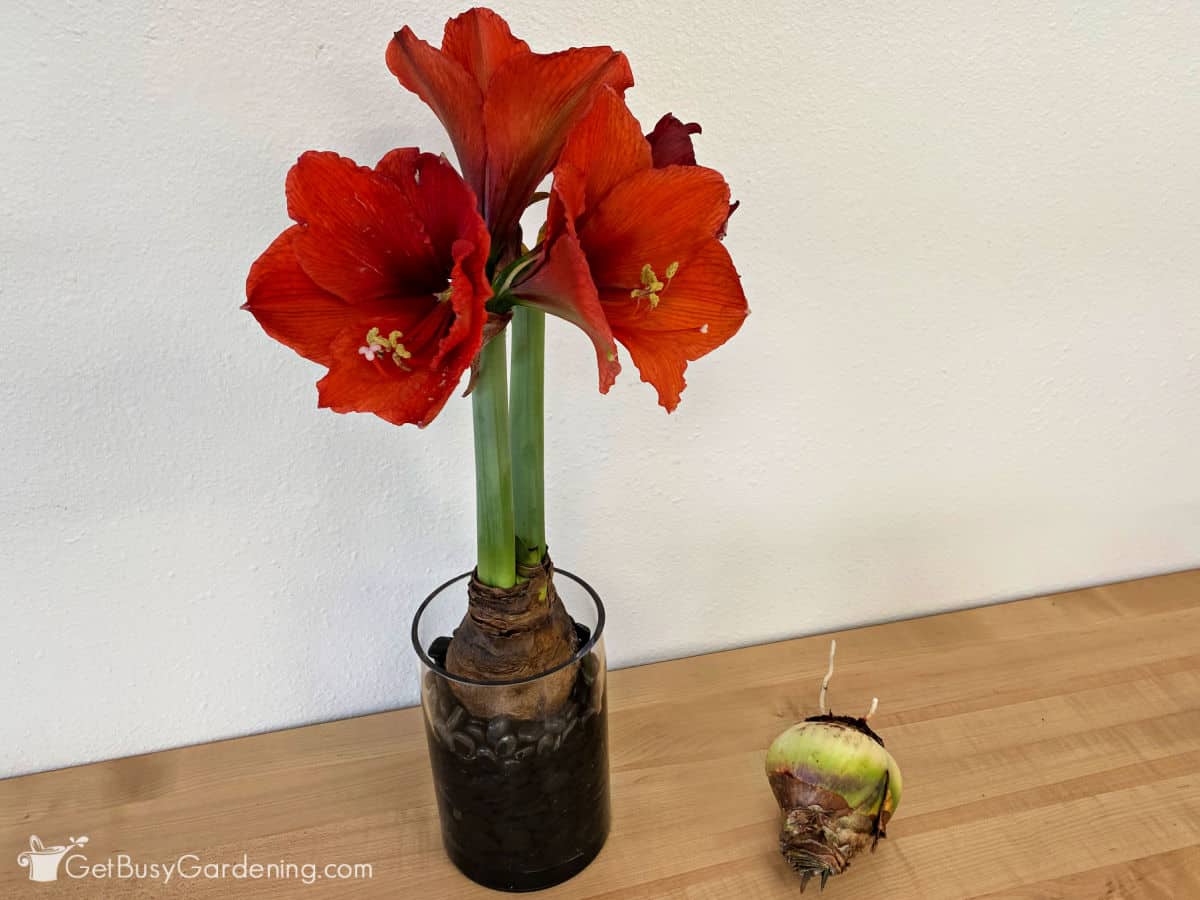
How To Grow Amaryllis In Water
To grow amaryllis in water, all you need is a bulb and a couple of items you can find around the house. This is a super easy project, and only takes about 20 minutes to complete. Here’s what you’ll need and the steps to follow.
Supplies Needed
- Amaryllis bulb
- Flower vase or bulb vase
- Decorative pebbles, glass marbles, or rocks
- Floral snips or bonsai shears
- Room temperature water
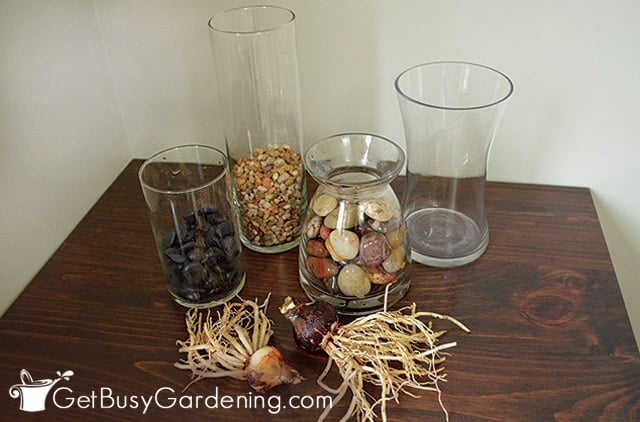
Steps For Planting An Amaryllis Bulb In Water
Step 1: Choose your vase – Any flower vase you have on hand will work, and it doesn’t have to be clear. Be sure to use one that allows room for the roots.
Something that’s between 5-8″ tall is perfect, it doesn’t need to be super deep. I used a 6″ tall cylinder and a 6″ bulb vase.
Step 2: Choose the pebbles – The pebbles are not only for decoration, they also help to stabilize the bulb and hold it up and out of the water. You could use rock or glass marbles rather than pebbles.
For my project I chose to use two kinds of river rock, one is multi-colored, and the other is plain black.
If you use a bulb vase and your bulb is large enough to sit on top of the rim, then you don’t need any pebbles (unless you like them for decorative purposes).
Step 3: Trim off any dead roots – Before you grow an amaryllis bulb in water, you should check the roots. Dead or damaged roots will decay and make the water murky and stinky very quickly.
Use your floral snips or bonsai shears to remove any that aren’t firm and white. If your bulb doesn’t have any roots, that will work too. In that case, you can skip to step 5.
Related Post: How To Store Amaryllis Bulbs For The Winter
Step 4: Rinse the dirt off – If your amaryllis was previously growing in dirt, then you’ll want to rinse any remaining debris and soil off the roots before planting the bulb in water. This will help to keep the water clear and fresh.
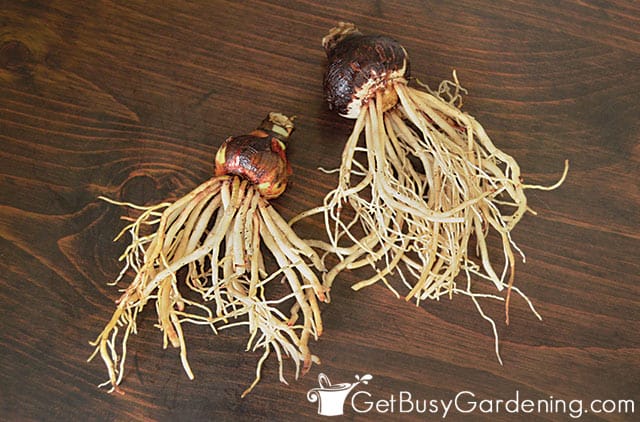
Step 5: Position the bulb – Position the bulb in the vase at the level you want it with the pointy side facing up. If your vase is shallow, you can trim the roots a bit to make the bulb sit lower, or cut the roots off completely.
If your amaryllis bulb doesn’t have any roots, then you can fill the vase with pebbles first (step 6), and place the bulb on top of the pebbles.
Step 6: Add pebbles to your vase – Slowly add your rocks, pebbles, or marbles to the vase. If you’re working with a glass vase, take care not to drop them in, or it could break the glass.
You might find it easier to tilt the vase sideways so the rocks will slide into the bottom slower.
Rotate the vase as you work to fill it with pebbles so that your bulb stays centered in the vase, and to hide as many of the roots as you can. You can also gently shake the vase so the pebbles will settle evenly.
Related Post: Dormant Amaryllis Care, Timing, Preparation, and How To Revive It
Step 7: Fill vase with tepid water – Fill your vase with room temperature water until it’s just below the bottom of the bulb but not touching it.
The trick to successfully growing amaryllis in water is to make sure the bulb never touches the water, or it will only rot. Take it from someone who has made this mistake before, a rotting bulb does NOT smell good. (GAG!)
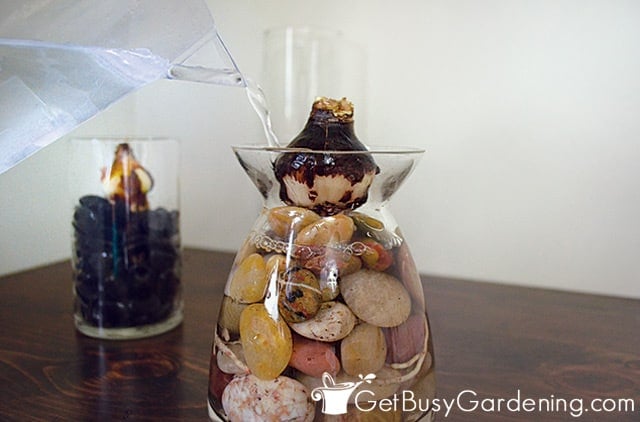
Step 8: Place your bulb in a sunny location – Move the vase to a warm, sunny spot. Refresh the water weekly and wait for it to grow. It can take a few weeks to show signs of life.
Sometimes the leaves will come first, and other times the flower will. Don’t worry if the leaves start to grow first, that doesn’t mean it won’t bloom. Just give it more time.
Related Post: What To Do With An Amaryllis After It Blooms
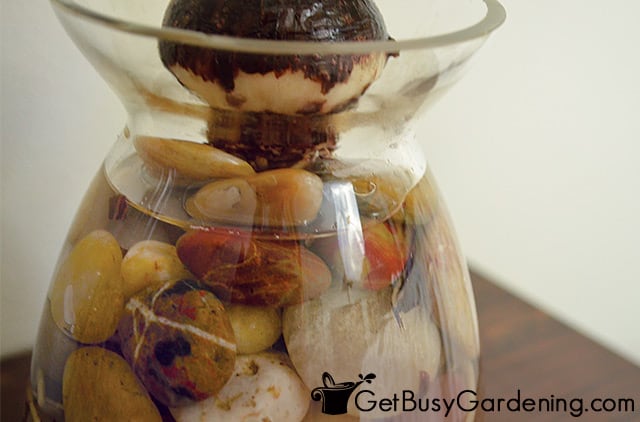
Tips For Growing Amaryllis In Water
Caring for an amaryllis growing in water is a bit different than it is when they’re planted in soil. Below are some tips for the best success, you can read my complete amaryllis plant care guide for more details.
- Keep an eye on the water to make sure it doesn’t evaporate completely, you never want the roots to dry out.
- Try to maintain the water level so it stays just below the bottom of the bulb at all times. Remember, if the bulb is ever sitting in water, it will rot.
- Make sure to keep the water fresh so that it stays clean. Flush the vase once a week for best results.
- When your amaryllis starts to bloom, the flower spike will grow quickly. They tend to reach towards the light, so turn the vase every day to keep it growing straight. You could also add a grow light.
Related Post: How To Grow Waxed Amaryllis Bulbs
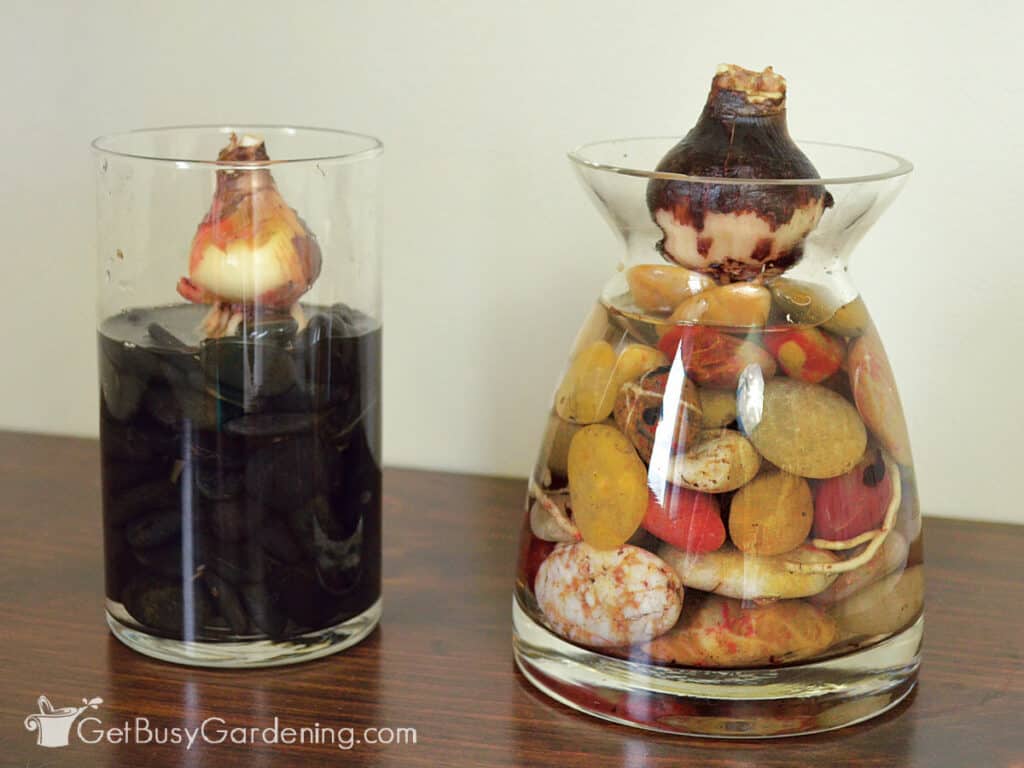
The Downside Of Forcing Amaryllis Bulbs In Water
Forcing amaryllis in water is a fun project, and can add a lovely dramatic effect to your Christmas or holiday decor. But… there is a downside.
If you do this keep in mind that many times you will need to toss out the bulb because it won’t grow very well afterward, especially if it starts molding or rotting.
However, if the bulb is firm and isn’t showing any signs of rot when you remove it from the water, then you certainly could try planting it in soil. But it may take a few years before your amaryllis will bloom again.
FAQs
You can grow an amaryllis just in water, but only for one bloom cycle. After it’s done flowering, check the bulb for any signs of rot. If it’s healthy and firm, then plant it in soil. It will not survive in water for more than a few months.
After your amaryllis blooms in water, then you should pot it up into soil. First check to make sure it’s still firm and healthy, then plant it in a container using a well-draining potting mix.
An amaryllis bulb can grow without soil, and even bloom. However as soon as it’s done flowering, you should pot it up if you want to keep it alive.
Yes, you can cut an amaryllis flower and put it in water. They make excellent cut flowers and will last for about 2-3 weeks.
If you want to learn all there is to know about maintaining healthy indoor plants, then you need my Houseplant Care eBook. It will show you everything you need to know about how to keep every plant in your home thriving. Download your copy now!
More Houseplant Care Posts
- How To Save A Rotting Cactus Plant
- Fall Houseplant Care Guide
- How To Melt Snow For Watering Houseplants
- Christmas, Thanksgiving, & Easter Cactus: How To Tell Them Apart
- How To Mount A Staghorn Fern (Platycerium) Step By Step
Have you ever tried growing amaryllis in water before? Share your tips in the comments section below.
Printable Instructions
Growing Amaryllis In Water
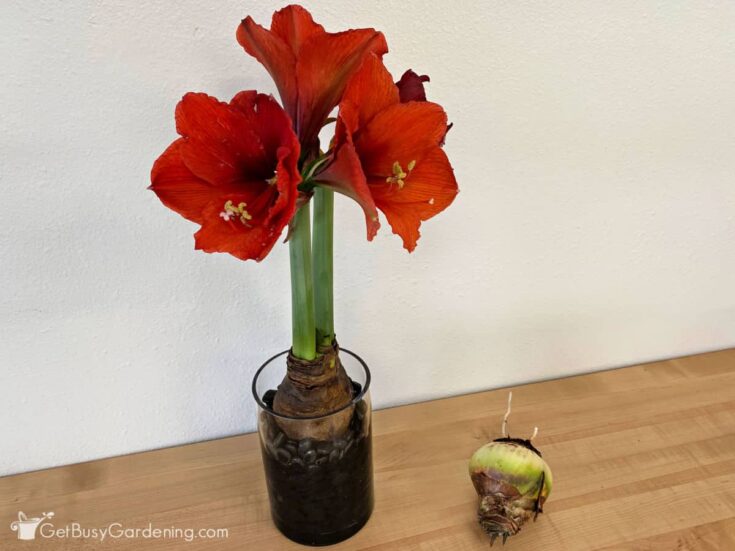
Growing amaryllis bulbs in water is a fun and easy project, and can add a lovely dramatic effect to your Christmas or holiday decor. Learn how to do it with these step by step instructions.
Materials
- Amaryllis bulb
- Vase
- Decorative rocks
- Floral snips
- Room temperature water
Instructions
- Choose your vase - Any flower vase you have on hand will work. For my project, I used a 6" tall glass cylinder and a 6" bulb vase.
- Choose the pebbles - You can use decorative pebbles, rocks, glass marbles, or any other water-safe vase filler. I chose to use two kinds of river rock: multi-colored in one vase and plain black in the other.
- Trim off dead roots - If your bulb has roots, then use your floral snips to remove any that aren't firm and white. Dead or damaged roots will decay and make the water get yucky (and stinky) very quickly. If your bulb doesn’t have roots, skip to step 5.
- Rinse off any dirt - If your amaryllis bulb was previously planted in dirt, rinse the roots to remove any remaining debris and soil. This will help to keep the water clear and fresh longer too.
- Position the bulb - Position the bulb in the vase at the level you want it with the pointy side facing up. If your vase is shallow, you can trim the roots or remove them all together to make the bulb sit lower. If your bulb doesn't have any roots, skip to step 6.
- Add the pebbles - Slowly add your pebbles to the vase. If you're working with a glass vase, take care not to drop them in, or it could break the glass. You might find it easier to tilt the vase sideways so the rocks will slide into the bottom slower.
- Fill with tepid water - Fill the vase with room temperature water until it’s just below the bottom of the bulb. Make sure your bulb is not submerged.
- Place your vase in a sunny location - Move the vase to a warm and sunny location and wait for your amaryllis bulb to start growing. Refresh the water weekly to keep it clean and topped off.
Notes
- If your bulb is large enough to sit on top of the rim of the vase, you can skip the pebbles.
- Never let the water touch the bottom of your amaryllis bulb or it can rot or mold.
- You may need to discard your amaryllis bulb after forcing it in water, especially if it starts to rot or gets moldy.
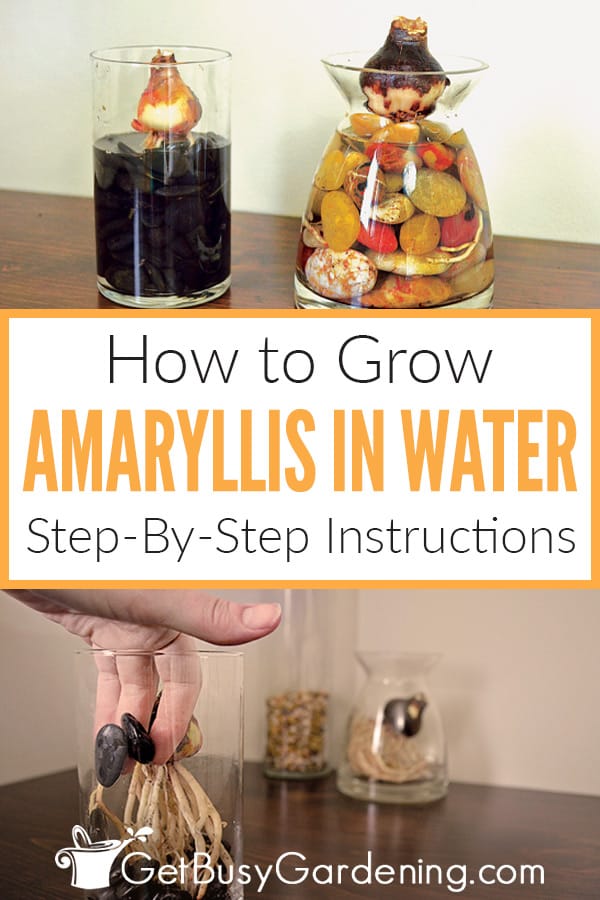
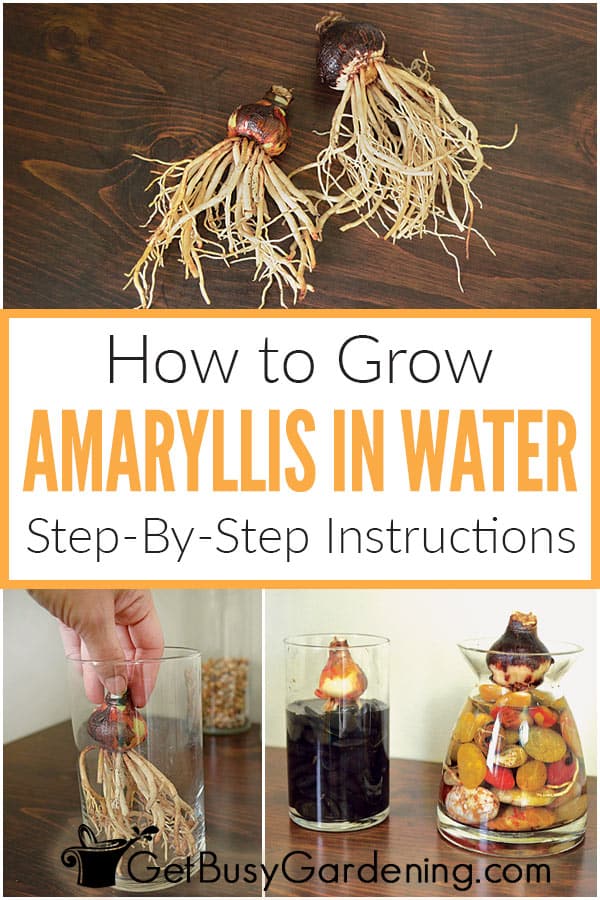
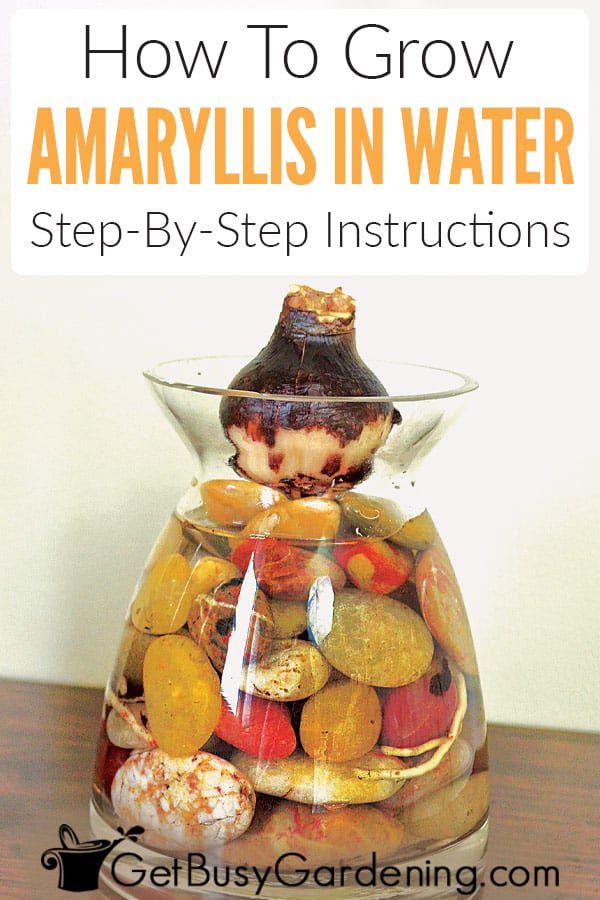

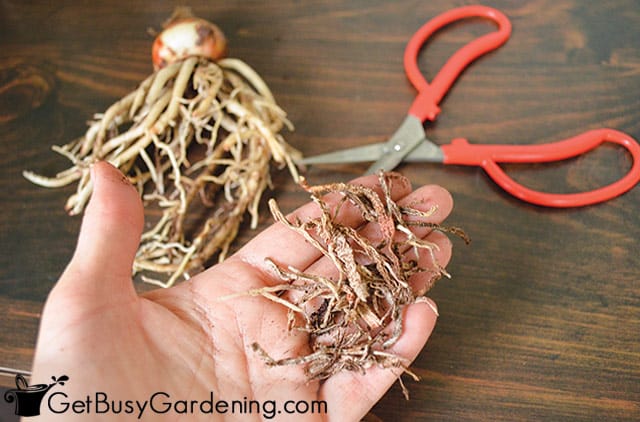
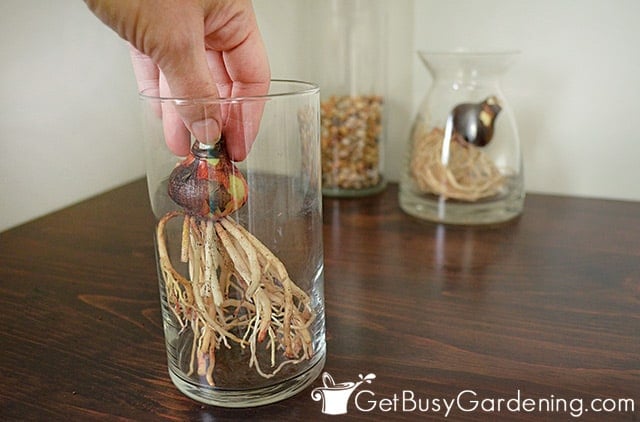
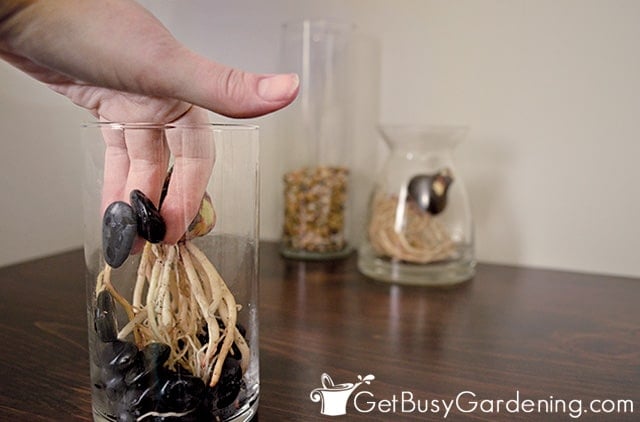


Kami says
Hi Amy,
I live in Palm Springs, Ca. I received an Amaryllis bulb for Christmas and put it in a large vase with water. The vase is narrow at the bottom and wider at the top so the bulb never touched the water. I have the roots about halfway in water. It grew beautiful flowers about three or four different times during the holidays but now it just has seven long green leaves on top. I don’t want to put it outside because it will be too hot during the summer here in the desert. What do you recommend me doing to save it for next Christmas?
Amy Andrychowicz says
Yay, glad to hear it did so well for you! First, I would definitely pot up your amaryllis into soil as soon as you can. The longer it stays in the water, the more likely the bulb will rot. Then you can keep it indoors as a houseplant, but it will need to be in a very sunny window, or you’ll need to use a grow light to keep it from getting leggy. Here are a few supporting articles that will give you more info…
– How to Rebloom Your Amaryllis Step By Step
– How To Care For An Amaryllis Plant (Hippeastrum)
Ed Markeset says
Thank you Amy for your good advice on growing amaryllis in water. I had 5 amaryllis growing in water but now only one since they were slower growing than those in soil. The 4 did not show sign of growing compared to the ones I planted in soil containers. I may have acted too impatiently because the one in water is now growing leaves better than the others. But no sign of flower even though it is only 5 days to x-mas. I probably did a mistake and let the water higher then the underside of the bulb. I have been trying hard this year to get my amaryllis to bloom before x-mas but it does not look so. I live in Mexico and the amaryllis normally bloom in February. This year I tried the advices I have read about here but so far have not given any flowers. In July and most of August I put my amaryllis into dormancy, some in pots and some without soil. The amaryllis I have in my garden I stopped feeding and watering until September. It is now almost X-ams and no flowers. I am disappointed, what did I do wrong?
Amy Andrychowicz says
Yes, amaryllis bulbs don’t always grow as well in water as they do in soil. Growing them in water is really more for a fun holiday display than a long-term situation. I would definitely check your bulb to make sure it’s not rotting, especially if you think it was sitting in the water. The plants need a lot of light and flowering fertilizer during the spring and summer to bloom. It sounds to me like you’re getting the timing right, but maybe your plants aren’t getting enough light/fertilizer during the active growing season? Here are a few guides to help you out..
– How To Care For An Amaryllis Plant (Hippeastrum)
– How to Rebloom Your Amaryllis Step By Step
– What To Do With An Amaryllis After It Blooms
dianne says
I dug up all my amaryllis bulbs this early spring..Mostly small ones, I just put them in a container in my garage without anything else. I had to leave my home in south Texas for several months and now they all have mold and a long skinny bug crawling around them. I removed most of the moldy paper skin from them, mostly very small bulbs leaving the tender inner skins exposed.. the tips are black and probably penetrates down to the center. Is this root rot or just fungus and is there ant way to save them?
Amy Andrychowicz says
It sounds like it could be rot to me, unfortunately. I would lay the bulbs out in a protected location to see if they will dry out. But if the black tissue penetrates down to the center, then it doesn’t sound good to me. For the future, here’s how I recommend storing amaryllis bulbs. Good luck!
Sandra Sherwood says
I just what to Thank you for all the information on how to take care of Amaryllis that are being grown in water. I was on another website it was a live chat and I didn’t feel like the person knew what she was talking about. You have helped me out with all my questions. Thanks again for your help Amy 😉
Amy Andrychowicz says
You’re welcome, so happy that you found the article helpful, and that I was able to answer all of your questions! 🙂
Yesenia Rivera says
One of my bulbs has root rot. Can I save it by cutting the rot and starting over with fresh water??
Amy Andrychowicz says
Oh no, sorry to hear your amaryllis bulb is rotting, that’s one of the big risks of growing it in the water, unfortunately. You could certainly try cutting off the rot. Depending on where it is, and if it’s not too bad, it could work. Certainly worth a try.
Kim Sutherland says
Thank you for such great info. So glad I found your site. I need Help! I was given two giant amaryllis bulbs 6 and 5 Xmas’s ago and grew both of them in vase with water and pebbles. It bloomed 4 more times during each subsequent Xmas winters and thru out the year it had long green leaves still in the same containers. I never changed the water, nor give it any nutrients but this year 2021, after both blooming at 2020 Xmas, one grew a few leaves and now nothing. I always cut the leaves off if it starts to yellow too much. The other one still had leaves. Both have dark waters and now i noticed it is smelly when you get close. I daily fill the water up to the 1/5 bottom of the bulb to keep the roots wet. After reading your blog I realized I did many things wrong. I just now emptied the old water, removed all the brown dried old residue from past cut leaves and also as much as i could the rotting dark stuff around the bulb bottom. They are both still sitting in their glass containers. I have never let them dry out for dormancy period as I really didnt know nor kept the bulb completely out of water. Yikes, in removing the rotting bulb material, i accidently got the bulbs all wet with faucet sprayer too.
Can these be saved? The bulbs still look firm after removing the outer yucky wet black layers its now showing the white greenish insides and both have lots of roots. Is it too late to put them into dormancy? Am I suppose to trim all the roots back if I do let them dry out?
These bulbs produced Red huge beautiful flowers that showed in four direction. I’m sad I did such a poor job of taking care of them and yet they somehow survived and bloomed all these past years.
Also, in 2020 I bought a bulb that has wax around it and it did not ever need watering. It also produced red blooms that were lovely. The bulb still has two green short pointed leaves about 2 inches tall that came out after I cut off the bloom stem so I havent thrown it out yet as it still looks alive. Do you think this waxed one will bloom again? Its amazing it never needed any water or care.
Amy Andrychowicz says
WOW, I am amazed that your amaryllis bulbs have survived growing in water for so many years – and rebloom every year no less. That is truly amazing! It sounds to me like the bulbs are still healthy, and should be able to survive after the near miss of rotting. If I were you, I would pot them up into potting soil, and leave them there for the summer so they can get used to growing in soil rather than water. If they are healthy and doing well by fall, then you could try forcing dormancy on them, and begin getting them used to the normal growth pattern. Definitely don’t force dormancy now, or they will be really confused – and it could put them into shock (which they may not recover from). Here are a few additional articles that will help…
How To Care For An Amaryllis Plant
How To Rebloom Your Amaryllis Bulbs
Lance says
I’ve tried growing amaryllis and hyacinths in water and they made great roots and the hyacinths had little flowers, but then everything stopped and seemed like started to die. The water turned darker color and is starting to smell. I emptied the water and added fresh, but is there anything I can do to save them? The leave’s of the amaryllis and all the roots are still very alive. Also, is there any problem with combining amaryllis and hyacinth in one container? I have amaryllis in the center surrounded by 3 hyacinths.
Amy Andrychowicz says
There shouldn’t be any problem combining the two types of bulbs in one container. Check to see if they have started rotting, that may be what is cause the water to be dirty and stinky. Amaryllis aren’t meant to grow in water for the long-term. So, if you want to try to save it, then I would pot it up into soil.
Jenna says
I received an amaryllis bulb without roots for a gift. How do you suggest I encourage root growth in the water without causing root rot? Thank you for the nice article!
Amy Andrychowicz says
You can follow the same steps for planting an amaryllis bulb in water above, but just place it on top of the rocks for support. Keep the water level just below the bulb. The bulb can bloom even without roots, so there’s not worries if the roots don’t end up growing until after it flowers. Good luck!
Nancy says
I received a beautiful large pink amaryllis bulb from Holland, which I’m growing in water. GORGEOUS! But now the petals are wilting and the bulb is soft in spots. Can I save it??
Amy Andrychowicz says
Oh bummer! Unfortunately, it sounds like your bulb may be rotting. You certainly could try planting it in soil to see if it will recover. However, if the bulb is rotting, then you may not be able to save it. Good luck!
Beth says
I have the same issue; lovely red blooms in water, but now what? I can’t find any info on what to do to transplant my water blooming bulb to a potted one! Can anyone help?
Amy Andrychowicz says
If your amaryllis bulb is firm and healthy, then you could pot it up into soil and keep it growing. You can simply use a general purpose potting soil, and a container that is only slightly larger than the bulb. Be sure to leave 1/3-1/2 of the top of the bulb sticking out above the soil level. If you plant it too deep, it may not flower. Here’s a detailed post with tons more information about potting up and also caring for it… How To Care For An Amaryllis
Chydi says
Can i use a vase like this with dirt? Rock on bottom for drainage?
Amy Andrychowicz says
No, definitely do not try to put dirt in the vase with your amaryllis bulb. That will only rot and make the water smell terrible. Only use clean rocks in the water, you want to keep the it clean and clear.